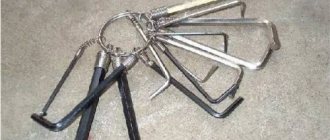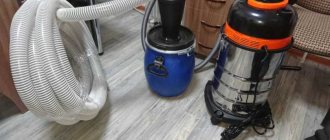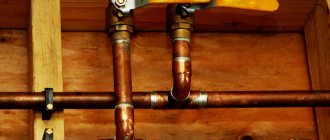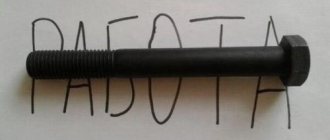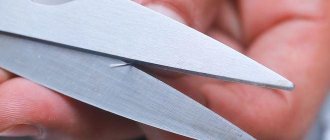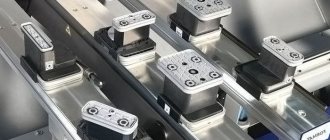The bolt looks like a cylindrical rod with an external thread cut at one end. At the other end it ends with a head. The thread can be cut only on parts of the rod or all the way to the head. The appearance of the bolts will differ depending on their purpose. The article mainly examines the option of hardware with an internal hexagon, which is used in construction, the automotive industry, for assembling furniture, in components and mechanisms, and in wood.
Allen Bolt
How to unscrew a hexagon: preparation
Whatever the reasons for the situation when the bolt stops unscrewing, the following steps should be taken before plumbing:
- Before unscrewing the hexagon, to reduce the coefficient of friction, it is necessary to open the bolted fasteners with lubricant such as WD-40, kerosene or brake fluid. You can start unscrewing the bolt 30-60 minutes after application.
- A stuck bolt can be gently tapped with a hammer so as not to further disturb the thread.
- If the location of the fastener allows, you can heat it with a gas burner so that the metal becomes more pliable and rust and dirt turn into ash.
How to remove a rusty screw?
There are many options for unscrewing a rusty screw:
- treat the screw with WD-40 and simply unscrew;
- use a cordless screwdriver;
- tap the head of the screw with a hammer and unscrew it;
- heat the screw, tap it, and unscrew it.
Interesting materials:
How to inject Sustanon 250 correctly? How to properly feed turkey ducks at home? How to feed Loman Brown chickens correctly? How to properly feed small piglets? How to feed laying hens correctly? How to properly feed bees in the fall? How to properly feed bees with honey in spring? How to properly feed Vietnamese piglets? How to properly paint walls over old paint? How to paint striped walls correctly?
How to unscrew a broken hex bolt
To unscrew a protruding hex or star bolt, you can use the following methods:
- Using a hacksaw or a grinder, make a neat and clearly vertical cut across the screw head. After these steps, you can unscrew it with a regular flat-head screwdriver.
- Using a Torx star: you need to drive it into the recess for the hex key in the hardware head. The size of the sprocket should be such that its splines do not fit into the hole. Then the hardware is unscrewed with a sharp jerk. It is not recommended to use a Torx with a hole in the center; the sprocket can break off.
- Before unscrewing the hexagon with torn edges, a drill with drills and extractors is used to drill a hole in its center. After this, the extractor is driven into it, then pulled out with pliers along with a hex screw.
- Using a drill with reverse rotation, a thin hole is drilled, then a hammer is inserted into it with left rotation and the fasteners are unscrewed. In this case, the rotation of the drill should be slow and the pressure should be strong.
Rusted nut
Another problem that is familiar to car enthusiasts (and not only) is a rusted nut and/or thread. In this case, you should not make heroic efforts to unscrew the fasteners. Your edges will simply “stick together” and another problem will be added to the boiling thread. If after a couple of attempts you can’t unscrew it, try the following methods one by one:
- Tap the bolt with a wrench. There is a chance that the rust will crack and the nut will be unscrewed.
- Fill the connection with kerosene and wait. It will eat away the rust, after which it will be easier to unscrew the rusted nut. But during this operation you cannot smoke, turn on welding, or be near an open flame.
Not the most elegant, but effective solution
- Warm up the nut. The metal will expand, making it possible to unscrew it. The trick is to get the nut to heat up while the bolt shank stays cold, so heating up must be fast. To do this, use a hair dryer or an open fire (be careful with this). If the screw is small, you can take a powerful soldering iron, heat it to maximum temperature, then quickly heat the joint.
- This method will (almost) destroy the nut, so it should only be used in hopeless situations. Grooves are made on the edges (using a metal saw, grinder, or file). A flat screwdriver is pressed into this groove, giving it a direction in the direction of unscrewing. The handle is hit with a hammer. If there is at least a couple of movements, it may be possible to unscrew it.
Removers for broken nuts - Use a special puller (pictured above). Using a bolt, the pin rests on one of the faces, after which you can try to move it from its place. Due to the fact that the lever can be attached, it can work even in very difficult situations.
How to unscrew an internal hexagon with torn edges
To unscrew a bolted connection with a through hole, you can use a file. With its help, the hexagonal hardware is bored to the next size and unscrewed with a wrench.
The second way is to use Torx. They can punch out new splines and reuse the hex hardware, but subsequently it can only be unscrewed with a Torx sprocket.
In addition, before unscrewing the torn hexagon, you can saw through the internal axis of the hexagonal fastener for a screwdriver and unscrew it. With this method, it is not always convenient to get to the fastener; sometimes its location does not allow the use of a screwdriver.
How to unscrew a hex without a key
Other ways to unscrew a bolt without a hexagon are as follows:
- If the size of the bolt is not too small, you can use a chisel or an ordinary hammer: they strike at an angle in the direction of unscrewing the fastener.
- Method using a spanner or gas wrench.
- If you have a problem with how to unscrew a “licked” hexagon, you can use a wrench with an attachment. The bolted connection is unscrewed using a hammer mechanism.
- Method of using welding: a small amount of metal with a nut or any piece of reinforcement is welded to the fastener, with the help of which it is then unscrewed.
- The extreme measure for unscrewing hex hardware with an internal axis is to completely dismantle the fastener, when cuts are made with a hammer and the fastener is disassembled.
Tools and materials for unscrewing the hexagon
You can unscrew the hexagon without a key. Sometimes you have to use the tools that are currently available.
A hexagon with torn edges can be unscrewed with an adjustable gas wrench and crimping the part.
- A hexagon whose edges have been torn off can be unscrewed with an adjustable gas wrench and crimping the part.
- Often its head is cut off with a grinder or removed with a chisel. Next, the central part is drilled with a small diameter, and the resulting thread is driven using a tap.
- A small hexagon is struck with a hammer or chisel in the direction of the upcoming unscrewing.
- If the diameter of the bolt being processed is small, a cut is applied to its head with a grinder, with the help of which an attempt to unscrew it can be made with a screwdriver.
Hexagon socket bolt: types, sizes, how to unscrew without a hexagon
The bolt looks like a cylindrical rod with an external thread cut at one end. At the other end it ends with a head. The thread can be cut only on parts of the rod or all the way to the head. The appearance of the bolts will differ depending on their purpose. The article mainly examines the option of hardware with an internal hexagon, which is used in construction, the automotive industry, for assembling furniture, in components and mechanisms, and in wood.
Allen Bolt
Why are fasteners needed?
Fasteners are the most important elements of mechanical engineering, which are used almost everywhere. The most common fasteners that have threads are:
A bolt, like a screw, is a rod with a head that has one threaded end. Screws are usually classified into two types:
- Installation ones that fix the parts mutually.
- Fasteners that are used for detachable connections.
Screw heads can be cross-slotted or single-slotted.
As a rule, this element is necessary if you need to attach an additional element. Often, a machine screw with a countersunk head is used instead of bolts, since the protruding head interferes with some mechanisms.
Most often, screws are used when there is a need to fix parts that have been mounted on shafts or axles.
Features and Benefits
An internal hex bolt differs little from ordinary bolts in appearance, but, nevertheless, their minor design feature makes them more durable, reliable and convenient.
Advantages of hexagon socket bolts:
- To tighten the screw, there is no need for free space around the hardware because the key used to tighten the fastener is inserted directly into the head, rather than overlapping it.
- The slot on the head is not so easy to lick off; it is more durable compared to the slot of a regular bolt, since the material of the hardware is denser than the material of the key, and the key is more likely to deteriorate than the fastener slot.
- A hexagon socket wrench is cheaper than an open-end or socket wrench.
- The head of the fastener does not have sharp outer edges.
- Bolts with an internal hexagon are used in hard-to-reach places, and after screwing in, the head does not remain on the surface, but sinks flush.
Countersunk screw
- Galvanized hex bolt hardware can be used in wet conditions because they are more resistant to corrosion.
- Hardware of this type can be dismantled and used again, just like the structure itself assembled with their help. Bolts can be used in combination with a nut: in this case, they are inserted into the hole, and the nut is screwed on the other side; or without a nut, then they are screwed into a threaded hole.
Hex screwdriver: parts and elements
“how to unscrew a bolt or nut with broken edges?”
The rod is one of the main elements. They are the ones who manage to screw in or unscrew hardware products. It is on the rod that the entire force load falls
Therefore, it is important when purchasing to pay attention to what material it is made of. It must be durable, not deformed and retain the working part even with maximum effort. Manufacturers usually take these requirements into account and use only high-quality and durable alloys
As already mentioned, steel is used to make the rod. After cutting the rods, the steel additionally undergoes heat treatment, that is, hardening. After this it will be more durable and reliable
Manufacturers usually take these requirements into account and use only high-quality and durable alloys. As already mentioned, steel is used to make the rod. After cutting the rods, the steel additionally undergoes heat treatment, that is, hardening. After this, it will be more durable and reliable.
The tip is made after the rod is completely ready. For this purpose, special forms are used. Hex screwdrivers are made in different shapes. When producing them, you need not only the diameter of the rod, but also the size of the edges themselves
The distance between the edges and their inclination are also important. Typically, such screwdrivers are used for screwing in and unscrewing bolts and screws that have hexagon-shaped recesses on the heads.
The hexagon tip helps to increase torque and screw in the connecting element quickly and efficiently.
Screwdriver handles are designed to transmit torque to the main working part. This means it must be strong and reliable.
Since the hexagon is more of a hand tool, it is important that the handle is ergonomic. Different materials are used to make handles: wood, plastic, rubber, etc.
Today, manufacturers are increasingly using powdered plastics. It is durable, hard, but at the same time fragile. A small impact may cause cracks. The most comfortable handles are made of rubber or polypropylene. Thanks to them, screwdrivers can last a long time.
Due to their peculiarity, hex screwdrivers are characterized by high torque. When compared with, they exceed their value by almost 10 times. The size of such devices is determined by the distance between the corners of the hexagons. It is usually measured in millimeters.
Table of types and sizes of internal hex bolts and their characteristics
Hardware of this type is made of carbon and stainless steel. They have thermal diffusion or galvanic coating with oiling; sometimes they produce samples with oiling, but without coating.
The color of the coating is light gray, dark gray and golden yellow. Black bolts do not have a protective coating, so they cannot be used in areas with high humidity or structures in contact with water.
An internal hex screw ensures reliable fastening of parts and is universal, but, first of all, it is necessary to select hardware of the appropriate type and size.
Types of hexagon socket bolts according to DIN
In terms of size, hardware corresponds to three accuracy classes: A, B and C. The marking on the head of the hardware corresponds to its class. The accuracy class determines how accurately the rod will correspond to the diameter of the hole prepared for it, taking into account the size of the bolt.
Due to the high degree of deflection, a Class C screw can become deformed under dynamic loads, however, it is easier to install because it fits easily into the prepared hole.
The parameters of bolts (screws) manufactured according to GOST 11738 / DIN 912 / ISO 4762 are presented in the table:
Hexagon socket bolt measurement diagram
DIN912 parameter table
Experts advise buying domestically produced products, since imported hardware may be labeled in an unusual way and vary in size.
Twisting methods
In cars, a screw with an internal hexagon is used to secure the plug in the engine sump and the transmission drain plug. In everyday life, a plumbing bolt with an internal hexagon is used to secure parts of a ball valve or mixer. Despite the strength of this type of hardware, the edges still break off under certain conditions, for example, if the hexagon is inserted incompletely or at an angle. Ways to solve a problem depend on the factors accompanying the problem.
In particular, if you cannot unscrew a bolt because it is stuck, you must first treat it with a rust converter and then with a lubricant like WD-40. Instead of WD-40, you can use kerosene or brake fluid - easy-flowing compounds. They penetrate into the smallest cracks and pores, lubricating the part and destroying rust. 30-60 minutes after applying the lubricant (sometimes you should wait longer - up to 10-12 hours), try to move the bolt from its place along the thread.
WD-40 lubricant
If the hardware still does not give in, you can gently tap it with a hammer or heat it. Heating should be carried out with an open flame of a gas torch, blowtorch or acetylene torch. Due to this effect, rust will turn into ash in some places, and the metal will become more pliable.
If it was not possible to unscrew the bolt without a hexagon using these methods, it is necessary to increase the applied force using a lever. To do this, select a metal tube of a suitable diameter, insert a key inside, one end of which is fixed in the stuck hardware, and, manually or using a hammer, try to unscrew the bolt.
Without hexagon
The hex key is S- or L-shaped and is often included with the furniture hex bolt kit for assembly. If you don’t have a wrench, you can use a bolt with an external hexagon of a suitable diameter and pliers, or better yet, a gas wrench. To tighten or unscrew a bolt with an internal hexagon without a hexagon, you need to screw 3-4 nuts onto the shaft of the hexagonal bolt, which is used as a tool, and jam them, insert the hardware with a hexagonal head into the recess, grasp the nut well with an open-end or gas wrench and turn a few times until fully tightened/unscrewed.
If for one reason or another the hexagon turns out to be useless, unscrew the bolt using one of the following methods:
Using the welding method
If all else fails, they resort to extreme measures - labor-intensive drilling. The work begins with the use of a thin drill: drill a hole exactly in the center. Then, using thicker drills, carefully drill it out. Eventually the bolt will crumble as the metal becomes thin.
Broken hex bolt
If the head of a bolt for a hex key or an asterisk protrudes above the surface and is not immersed in it, then the torn hardware can be unscrewed in the following ways:
- Using a grinder or a hacksaw for metal, make a transverse cut strictly perpendicular to the head. The depth of the cut should not be the entire depth of the head, but only 75%, otherwise it will break off.
- Then select a flat-head screwdriver of the appropriate width and unscrew the bolt like a regular screw.
- You can also unscrew the stripped hexagon screw using a Torx star. The size of the bit is selected so that the edges of the sprocket extend beyond the hole for the hex key. The Torx must be hammered into the recess, and then the hardware must be unscrewed with a sharp movement. It is important that the sprocket is solid, without a central hole, otherwise there is a risk that the sprocket will break. If that fails, you might want to try a 12-point bat. The main thing is that the bit is installed completely and without distortion.
12-beam bit
Internal hexagon with torn edges
If you insert the hexagon incorrectly: not deeply enough or skewed, the edges of the internal hexagon in the fastener can be torn off. Then certain difficulties will arise with unscrewing the hardware.
Hardware with torn internal edges
- You can unscrew a bolt with an internal hexagon by boring a hole to the next larger size. Boring is done with a needle file.
- Another way is to use a Torx star. Use an asterisk to punch out new splines and unscrew the fasteners. If desired, this hardware can be reused, but then you will need to screw it in and unscrew it not with a hex wrench, but with a Torx asterisk.
- If the edges for the hexagon are torn off, you can also cut a slot in the head for a screwdriver and use a flat-head screwdriver to unscrew the hardware. However, this method is applicable in most cases only if the bolt head is above the surface. It is not always convenient to make a cut in a recessed piece of hardware, just as it is sometimes inconvenient to use a screwdriver later.
- If the bolt head is not recessed, then you can grind it down under the external hexagon with a file or using a sharpening machine and unscrew it with a regular key.
The hexagon socket bolt is more reliable and durable. Its scope of application is much wider compared to a conventional hex head bolt. It can be used in hard to reach places. There are several design types of screws, including those that are installed flush with the surface. Hardware protected by a special coating can be installed in places of high humidity. A key marked DIN 911 is provided for tightening and unscrewing the hex screw. But it can also be unscrewed in other ways, for example using a regular hex bolt. To unscrew a stuck, torn bolt, hardware with torn edges of an internal hexagon, use specific tools and universal methods for unscrewing damaged screws.
Where to begin
Assess the degree of complexity of the problem: if the stripped screw is recessed into the structure of the material, complex methods are considered; To remove the fastener at the screwing stage, use pliers - they grab the head and unscrew it.
Before starting the product removal procedure, check that the screwdriver is selected correctly. To do this, check all types of tools. If the screwdriver is initially selected incorrectly, then you will not need to perform complex procedures for removing the fasteners. The problem will be solved by replacing the tool.
Precautionary measures
When choosing a way to unscrew a screw with torn edges, you must follow the recommendations:
- when using an auxiliary tool, you should control the intensity of the applied forces: sometimes, in order to remove the fastener faster, you have to press harder on it, but the situation will worsen in this case and, conversely, too careful actions with weak pressure will lead to even faster erasure of the edges of the slot;
- when the fastener is unscrewed too intensively or an auxiliary tool is used, during work with which metal shavings are formed (a hacksaw, etc.), it is necessary to periodically remove them, since the presence of foreign particles causes the tool to not fit tightly enough to the edges of the slot, what will slow down the work;
- It is recommended to wear safety glasses when removing a screw without a head, since during the procedure, metal shavings may form when using a power tool;
- you need to know which way to unscrew the screw, so, in most cases, hardware is made with a right-hand thread, which makes it possible to install the fastener by screwing it clockwise, and it is removed, on the contrary, when the screwdriver moves in the opposite direction.
When using an auxiliary tool, the intensity of the applied effort should be controlled
Rusty screw
Before tackling the question of how to unscrew a self-tapping screw that is susceptible to corrosion, you should consider all available methods:
- a blow to the fastener, in this case the integrity of the rust shell is violated, thanks to the vibration created by this, it will be easier to unscrew the rusted screw;
- use of an impact tool: the resulting effect is the same as in the first case; a manual or mechanical impact screwdriver is suitable;
- If the question is how to unscrew a broken screw, which, when trying to remove it, scrolls, and is also covered with rust, you should use the heating method, in which case the metal expands; after cooling, the product will shrink to its original size, as a result, the integrity of the rust shell is damaged, which allows you to quickly remove fasteners;
- an alternative method is the use of the chemical WD-40, a rust converter is used, which destroys the formed shell, however, a positive result can only be obtained if the entire surface of the screw is treated, this condition is often difficult to fulfill.
If corrosion occurs, all available methods should be considered.
How to unscrew a bolt with torn edges: methods of unscrewing
Quite often, serious physical effort and a lot of time are spent on solving minor problems. When performing plumbing work, you may encounter the problem of removing fasteners and separating structural elements.
So that in the event of “sticking” of materials, the work can be completed as quickly as possible, it is important to know how to unscrew a bolt with torn edges without damaging the outer body of the product. To do this, it is enough to study the order of work and universal methods of its implementation.
How to prevent edges from being torn off
To prevent such a problem as torn edges of a bolt or splines of a screw or screw from taking you by surprise, you must adhere to simple rules:
- You need to buy only high-quality fasteners that have high strength and reliability;
- When tightening and unscrewing screws or screws, do not allow the screwdriver to slip through the slots. This leads to their abrasion and it will be difficult to unscrew such fasteners;
- You should always monitor the condition of the instrument. If a screwdriver or key has licked edges, then it will be difficult to unscrew a screw, bolt or screw with their help.
It is much easier to prevent the edges of bolts, screws and screws from licking off than to then unscrew damaged fasteners.
Do not panic if a problem appears such as a licked bolt head or slots on the head of a screw or screw. There are many ways to solve it. It is necessary to adequately assess the situation and choose one of the available options.
Almost all equipment is assembled using fastenings that use bolts or other products. But when it becomes necessary to unscrew them, they may turn out to be rusted and no longer suitable for use.
These elements often end up with torn edges, threads, or their head breaks off. But how to unscrew a bolt with torn edges without ruining the entire structure?
Causes
The occurrence of such problems can be due to various reasons. “Sticking” of the material occurs:
- Due to the fact that the fastened parts were displaced.
- As a result of excessive “tightening” of the bolt during initial installation.
- Due to corrosion of the fastener head and the appearance of rust.
- Due to the use of inappropriate tools (for example, instead of a 13 key, a 14 key is used and a screwdriver is placed under it, which leads to “licking” of the bolt edges.
Main characteristics
A hex bolt is a type of fastening tool, characterized by an internal head in the form of several edges. This allows it to be made with the same diameter as the main rod.
Such bolts are used in various fields:
- the furniture sector is used to fasten several parts into one;
- complete set of plumbing mechanisms. The hexagon can often be found on the mixer, which secures the main handle, etc.;
All types of such fasteners also have a peculiar division according to standard sizes. For each of them, a corresponding key is standardized, often having a curved shape in the form of the letter “G”.
Preparatory activities
If the edges are torn off, you can unscrew the bolt only after preparatory work. The work must be carried out without fail, regardless of the reasons that provoked a violation of the integrity of the fastening element.
- It is much easier to remove a damaged bolt or nut if you first apply a penetrating liquid (like WD-40) to the product, which reduces the level of friction. After applying such a solvent to the threads, you can start working in about 1-1.5 hours. It is noteworthy that it is not necessary to use expensive products, since a special penetrating liquid can be replaced with kerosene or brake fluid.
- Before unscrewing a bolt with a torn head, it is necessary to subject it to a certain load, that is, gently tap the stuck fastener with a hammer. As a result of such manipulations, the durability of the bolt will decrease, which will simplify the task of removing it. According to the design, you should not hit it too hard so as not to deform the fastener.
- Depending on the situation and location of the fasteners, you can try to heat the stuck bolts using a gas torch. This will remove rust and dirt, turning it into ash, and will also warm up the metal and make it more pliable. You can also use a set of spanners, a grinder, a file or a welding machine.
It is quite good if there is space near the problematic connections, thanks to which you can use an adjustable wrench or pliers when unscrewing. It is important to take care of the condition of the auxiliary materials so that they are in good working order, since when working with bad tools the situation can only get worse.
Welding hexagonal shape
Now all that remains is to weld the part into one. (In my case I used a 2.5mm welding electrode)
After this, you need to try on the nut again, and if everything fits, you can fill the cuts with welding. (3.2 mm electrode).
We try to put it on the nut again, because the high temperature during welding can deform the metal.
(This time I additionally tried the blank on the hexagonal protrusion on the filter.)
After this, you can clean up all the excess, making the shape of the part smoother.
Methods for removing bolts with torn edges
Only after a series of preparatory work has been completed and the necessary tools have been selected, can you proceed directly to the extraction procedure. There are various ways to unscrew a bolt with torn edges, so it’s worth considering each of them:
- using gas (pipe) wrenches. The use of this method is relevant with sufficient space for work. Such a tool is universal, since it can be used not only for surfaces with edges; it is good at unscrewing cylindrical parts that have absolutely no threads. The larger the pipe wrench, the less force is required when working with it.
- removing a damaged bolt using spanners with different sets of heads. When unscrewing, you should pay attention to selecting the required diameter of the head, since it is necessary to avoid its twisting and interaction with the fastener.
If you cannot unscrew a bolt with torn edges using the described methods, then you need to move on to other measures, more effective, complex, but effective.
Star bolt
You can unscrew such a bolt in the same way as unscrewing a nut with torn edges. We discussed the main methods of unscrewing stubborn bolts and nuts in great detail earlier, and now we can summarize all the methods that are suitable for such a screw. So, if your star bolt has stripped edges:
We have looked at options for releasing bolts and nuts that are available for use by any home craftsman. Of course, methods used in professional workshops or car repair shops were left out of the discussion. However, they constantly use equipment that you might only need once or twice at home. And it costs a lot of money. Professionals use to release bolts with torn edges:
However, if such situations occur to you no more than once a year, then there is little point in purchasing special tools.
Unscrew the hex bolt with torn edges
As a rule, fasteners can be made in various versions, so the methods for removing them are somewhat different.
Hex head bolts (asterisk)
The following bolts are removed:
- Flat screwdrivers. To do this, you need to make a notch cut on the cap in advance. The walls of the cut must be vertical so that the tool does not jump off.
- TORX sprocket with suitable size. It must be selected based on the principle that the splines do not fit into the hexagon hole, but also that it is not excessively large. With such an asterisk, a slot is cut through the head of the bolt when it fits tightly into the head. After this, the bolt is jerkily unscrewed to avoid breaking the spline on the sprocket. For such work, you should not use TORX sprocket models with center holes, since they may break off during the driving process.
- Drill, drill and special extractors. To extract, you need to drill a hole in the center and hammer the appropriate extractor into it. Then, using pliers, you need to unscrew it along with the fasteners. This is not difficult to do, since the extractor has threads cut opposite to the bolt threads.
- A drill with reverse and drills with left rotation, the diameter of which is less than the diameter of the damaged bolt. First of all, using a regular thin drill, a small hole is made, after which the drill is installed, and the drill is turned on in inversion rotation mode.
Hex Bolts
The following bolts are removed:
- using a needle file, by enlarging the connector to the next hexagon size (this method makes it possible to reuse the bolt);
- TORX sprockets of the appropriate size;
- flat screwdrivers, if a notch has been prepared in advance on the head of the fastener;
- through extractors that are screwed into a hexagonal hole.
Alternative methods for unscrewing bolts with torn edges
If the threads are completely stripped, pipe wrenches may be useless if there is not enough space to manipulate the tool. In this situation, the most successful solution is to create new edges on the bolts using files.
The edges of the old base are ground down to the specified new size, so that spanners with heads of the required diameters can be used. Some experts give advice on welding a new nut to the head of an old bolt.
If the fastening materials are excessively large, then the right solution would be to use welding to apply a metal coating to the surface of the damaged edges. And only after this is it possible to cut out the required shape to install the key.
A simpler, and in some cases more effective, method is to use a hammer and chisel to split an intermediate piece (a plastic gasket or a rusty washer) between the surface of the bolt and the body.
In such cases, blows are applied directly both to the nut and near it, maintaining a certain angle and slope in the direction of unscrewing the bolt.
Some craftsmen prefer to drill out a bolt with a broken edge using a drill. In such cases, a hole is drilled in the middle of the fastening element structure into which a special L-shaped rod is installed. This device acts as a handle that allows for extraction.
Any of the methods described above can be done even by a person who has no previous experience in plumbing work. If you use the right tools and related equipment, no one will have any difficulties. By following the recommendations presented, you can easily unscrew a bolt with torn edges with the slightest time and physical effort.
Preparing to unscrew
Before unscrewing a bolt with torn edges, it is necessary to do a number of preparatory measures . They make it easier to unscrew.
- Regardless of the reason for which the edges were torn off, it is first necessary to treat the joint with a penetrating liquid. Not only the well-known WD-40, but also kerosene, brake fluid and, oddly enough, ammonia can act as a penetrating liquid. All of them have great penetrating power. After application, you should wait from half an hour to an hour to get the effect.
- You can destroy the interatomic bonds of metal parts by hitting the bolt head with a hammer. But in order not to damage the thread itself, the blows should be applied lightly and carefully.
- If there are no rubber or plastic parts nearby, the hardware can be heated using a gas burner. At the same time, the burner flame burns out dirt and oxides. Heated metal is more pliable.
- If the connection is assembled using washers made of metal or plastic, then the head of the fastener can be released by cutting it off with a grinder or splitting it with a chisel. True, such work can only be done if there is enough space around.
How to quickly unscrew a bolt with torn edges in a hard-to-reach place?
How to unscrew a screw with a broken head?
There are several ways to get such a screw:
1) Firstly, if its head protrudes above the surface of the material, you should use pliers, a gas wrench or pliers. It is enough to grab the screw with one of them and try to turn it. It must be unscrewed in a counterclockwise direction.
2) If this gentle method does not help, then you should take radical measures and drill out the fasteners to its base. It is recommended to use an automatic drill with a metal drill for this purpose. Gradually, layer by layer, the fasteners will be removed from the thickness of the workpiece.
3) If there is minimal risk of damage to the material into which the screw is screwed, then you can try heating the screw. When the metal heats up, it will expand, and when it cools, it will free up space, allowing the bond to loosen. To achieve the goal, you can use a gas torch or a hair dryer, and then try to remove the screw with the same pliers.
4) Well, one more way. You can try to remove a screw with broken edges using glue. It must be applied to the head of the fastener and a nut of the appropriate diameter must be attached there. It is recommended to use epoxy metal adhesive, known as “cold welding”. As soon as the substance hardens thoroughly, you need to put a wrench on the nut and turn the fasteners.
How do you tighten huge bolts?
Surprisingly, in practice, huge bolts of, say, power line supports or heavy machinery are tightened by hand. There are special socket impact wrenches for this (the devices are easy to Google). Such a wrench is placed on the head of the bolt, after which the bolt is tightened with careful but persistent blows with a sledgehammer. Alternatively, the key can be long (or artificially lengthened using a metal profile) so that it can be pulled (again by hand or with a crane/tractor/winch.), but nevertheless, the final fixation is still, as a rule, impact.
Why did they come up with these new screws with hexagonal, asterisk, triangle, and triangular slots?
I have several options on this matter, which appeared after starting my studies in mechanical engineering.
a) In some cases, various splines help stop the bolt head from being destroyed when tightening/unscrewing. Also, to unscrew the screws, a different force is required, which is applied to the screwdriver (wrench, hexagon, etc.) in order to hold it on the head and it does not come off (for example, when using a hexagon, you just need to insert it into the head of the bolt and it will stay there, which will not roll with a regular flat-head screwdriver). You can list a bunch of other nuances that will relate to materials science, physics and design.
b) In some cases, this is also a kind of foolproof protection, for example, not every house will have a screwdriver lying around to remove the back cover of the same iPhone. This is done so that all sorts of “knowledgeable” uncles Vasya do not interfere where they shouldn’t, and then when they bring the equipment to the official service center, they say, I didn’t do anything, I didn’t go anywhere, it broke down on its own.
b) Most of the splines are patented, which makes it possible to quite reasonably charge money from manufacturers who use a patent for a particular spline.
How to remove the key from the lock if it is stuck?
There are two main types of locks: lever and cylinder (there are a few others, but they are very rare and we will not talk about them).
1) If the lock is lever-type (the key looks like a butterfly, two feathers in different directions), then in 99 out of 100 cases this is due to the fact that the decorative overlay is installed with a slight offset; it was possible to insert the key, but it was pulled out due to this offset fails. So just remove this decorative trim on the keyhole, and then the key can be easily pulled out. This trim is usually screwed on, meaning you only need a screwdriver. If you don’t have a screwdriver, then straighten the pad on both sides with your hands, this way it will loosen a little and this will be enough. To prevent the situation from happening again, attach the escutcheon exactly along the key hole yourself or use our locksmith service!
2) If the lock is a cylinder type (the key is small with teeth or dots), then (A) if the door is open, then it is enough to remove the bolt that holds the cylinder. It is located on the side of the door. If this does not help, simply unscrew all the screws and bolts until the cylinder comes out of the lock (when you pull out the cylinder, try to turn the key at the same time). Important tip: remember where the screws were, this will help when putting the lock back together. (B) If the door is closed, then it may not be possible to keep the larva intact. A jammed lock cannot be easily unjammed. Try gently twisting the key, inserting it all the way, then twisting it. Don't use brute force. If you can’t get the key out successfully, then you need to open the lock. Here I recommend contacting a specialized service.
0 0 votes
Article rating
